Lee Wylie On Kovalev vs Ward
Lee Wylie remains one of the most respected analysts in boxing and The Fight City is proud to be the home of his outstanding work. This coming Saturday, fight fans will witness one of the best match-ups pugilism presently has to offer, as two of the very best, pound-for-pound, clash for several light heavyweight title belts. For the defending champion, Sergey Kovalev, this is a golden opportunity to take his career and reputation to the highest level and become a huge attraction. For Andre Ward, it’s a chance to clearly establish himself as the most skilled boxer in the world in a post-Floyd Mayweather era. This mouth-watering match has inspired Mr. Wylie to compose what is likely the most in-depth analysis on Kovalev vs Ward that you will find anywhere. Check it out:

The Champion: Kovalev is well known for his ferocious two-fisted punching power and physical strength, but his ring acumen and boxing skills remain largely underrated. He is intelligent, deceptively fast, mobile and athletic, not stiff like many Eastern European boxers. His jab is a formidable weapon; thrown to the body, it may be the single most effective weapon in boxing today. And his right cross, thrown like a jab with little or no weight behind it, or with maximum power by pushing off with his right foot and then stepping forward with his left, is typically lethal. Except for maybe Terence Crawford, nobody in the current fight game epitomizes the term “boxer-puncher” better than Sergey Kovalev.
The Challenger: Confining Andre Ward to the limitations of a particular “style” is perhaps too simplistic. A master tactician and strategist, he is inarguably the most well-rounded fighter in boxing. His mental speed is off the charts, and when it comes to recognizing and solving problems based on the strengths and weaknesses of his opponent, none are better at adapting their tactics accordingly. Ward is equally at home mauling and brawling in close, as he is boxing at range behind the jab. A converted southpaw, Ward’s most powerful weapon is the left hook, though his most effective is unquestionably the jab, which he throws in numerous ways to both head and body.
Strategic And Tactical Considerations
Kovalev: Akin to a heat-seeking missile, if “Krusher’s” jab lands, then his right hand tends to follow. But Kovalev’s jab is a potent weapon in and of itself, and not just when applied as a range-finder or a set-up for the right. For instance, by reversing the order, Kovalev uses the momentum created from the cross to set up a powerful jab (technically, more of a left straight due to Kovalev’s body alignment upon completion of the cross). The jab surprises opponents as it travels from a blind spot and inflicts more damage due to Kovalev’s weight being shifted onto his lead leg. Kovalev prefers to chase and punish retreating opponents with this attack, but he will also lure his opponent forward and then catch him unprepared with a pot-shot right followed by the hard left. Finishing on the jab also enables Kovalev to efficiently restore balance.

What makes Kovalev’s jab and cross even more effective though, is the way he plays them off each other to confuse the opponent. In textbook fashion, Kovalev will flash a jab at the opponent’s eyes to conceal the right hand coming behind it. He will also sell his right hand via a little shimmy of his right shoulder, only to then pop the opponent with a stiff jab. Kovalev often befuddles his adversary further by slyly bringing his right shoulder and hip nearer to the target, pausing for a split-second, and then throwing the cross. The result is a faster, less predictable straight right. Watching Kovalev keep his opponent’s guessing with the jab and cross alone is evidence that sometimes it’s not how many tools you have in the toolbox, but rather the different things you can do with just one or two dangerous implements.
On a similar note, having worked his opponent into a corner or against the ropes, Kovalev will use a double jab-right cross combination as a building block to set up a left hook to the head or body. In this instance, the double jab and cross are mere throw-away punches used to occupy the opponent’s guard and load up Kovalev’s left side for a powerful delivery of the hook. There are also times when, having committed more to the cross, Kovalev will shrewdly take advantage of his opponent ducking to avoid the blow by pushing down on the back of the neck with his right forearm, which allows him to land a left hook to the body unimpeded.
Another way Kovalev creates openings is by feinting. There are numerous feints Kovalev uses – head, shoulder, arm – as well as some that are more flamboyant. For instance, when he has an opponent reeling, he will cock his right hand as if to throw a right hook, but will instead throw a stiff jab down the middle. Against opponents who back straight up, Kovalev sometimes throws his right hand short of the target and then steps through with his trailing foot to build momentum for a powerful left straight thrown from a more squared stance.
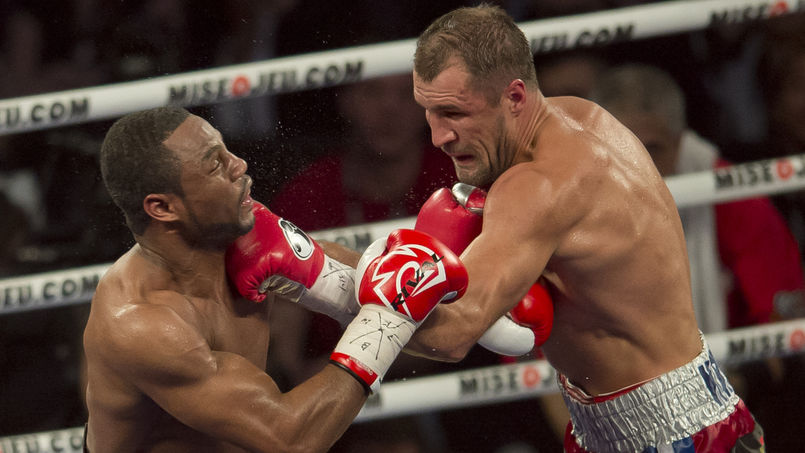
Most impressive, however, are Kovalev’s more menacing foot feints. He will step forward with his lead foot, as if to throw a jab to the body, only to then hop-step back, re-establishing his range, and then nail the opponent while he is out of position. Kovalev even managed to outsmart and knock down the venerable Bernard Hopkins with the same tactic in the opening round of their fight: Kovalev stepped in, stepped out, and then countered Hopkins coming forward with a right hand over the jab. Incidentally, Kovalev’s cross counter over the jab (a right hand timed to “meet” the opponent’s jab and often accompanied with an inside slip) has led to many knockdowns and knockouts and is definitely something to look for during the fight.
Kovalev’s ring generalship has improved tenfold since he began working with trainer John David Jackson, but it will need to be better still for Kovalev to control the ring and win rounds against a ring general the caliber of Ward. I don’t think Andre will be moving as much as he has in the past, but he certainly won’t be a stationary target. Thus Kovalev must restrict Ward’s movement by cutting off the ring, using feints to offset his rhythm and timing, and scoring consistently with that lovely long jab to the body. Kovalev’s spear-like straight right to the body may also serve him well whenever Ward is moving to his left. As a target, the body should never be neglected. It is the largest target area, and therefore the most difficult to protect. Ward’s conditioning is excellent, but hard body punches are guaranteed to take the bounce out of any opponent’s legs.

Ward’s chin will likely prove an elusive target. For that reason, Kovalev should hit him everywhere, not just the body, but the chest, arms, shoulders, hips, you name it. I wouldn’t be surprised if Kovalev targeted Ward’s lead shoulder with the jab, especially if Ward stays low and keeps his chin hidden behind it as he did in his last two fights (more on this later).
Kovalev is essentially a long-range fighter, so for him to be effective and ultimately win this bout, he must keep Ward under constant pressure while maintaining the distance necessary to not smother himself or allow Ward to clinch and maul. In addition, Kovalev must not get frustrated searching for the knockout. Rather, he just needs to let his hands go frequently, without overthinking things, and focus on winning the fight one round at a time.
Ward: The cunning challenger has many different jabs for many different occasions. He will use a regular jab to intercept the opponent and keep him off balance; a body jab to reduce stamina and create openings upstairs; a pawing jab to measure distance or obscure the opponent’s vision; a jab feint to note the opponent’s reactions; and a post jab, or stiff-arm, to keep the opponent at bay and set up more punches.

More appropriate for the job at hand though, is the one Ward will use to attack Kovalev from underneath: the up-jab. This blow is thrown from the waist and follows a deceptive, upward path to the target, aiming for the chin with the back part of the knuckles. By changing levels and slightly flaring his left elbow prior to delivery, Ward can land the up-jab from closer in without smothering himself and losing leverage. The up-jab is especially effective against taller, more upright opponents because it comes from below their field of vision.
Typically, Ward likes to get off first with the jab. But he will also catch his opponent’s jab in the palm of his right glove and return fire with one of his own, or he will simultaneously slip outside the jab, taking his head off-center, and jab with his opponent. Because Kovalev is a little taller and slightly longer than Ward, I imagine Ward will jab with Kovalev at some point to try and nullify the Russian’s long lead, maybe even aiming for Kovalev’s chest to disrupt his rhythm and forward momentum.
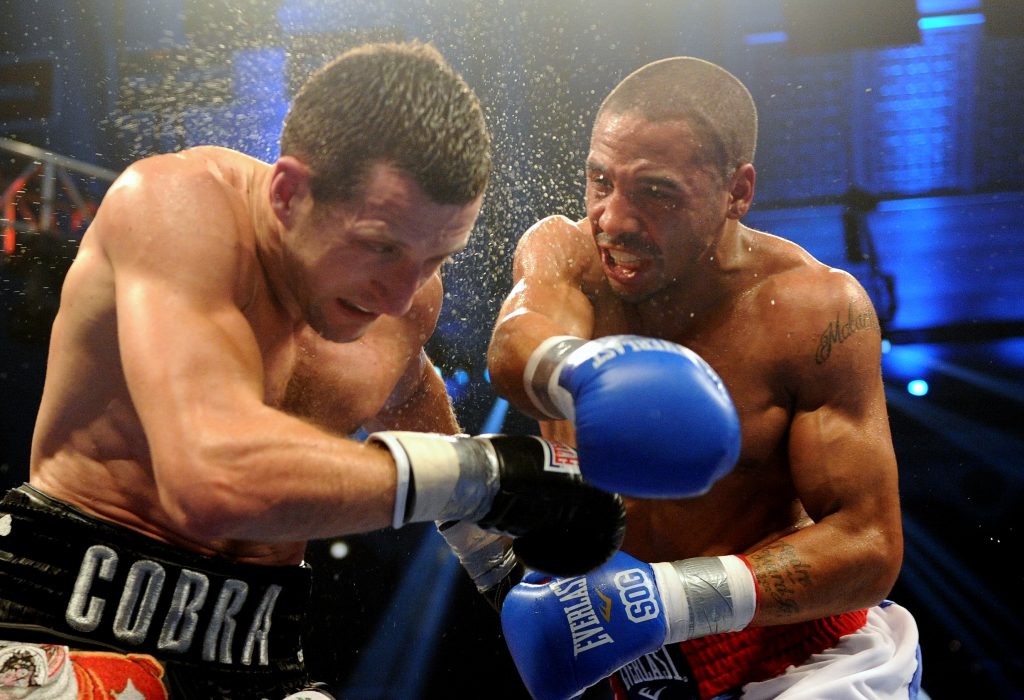
At no stage in the fight should Ward be backing straight up. As was mentioned earlier, Kovalev loves to have his opponents retreating linearly so he can pursue and catch them off-balance with combinations. Because Kovalev also covers ground very quickly, Ward will need to take the train off the tracks. If he’s not employing tight, efficient footwork to angle off, then he must utilize upper-body movement. As an example, if the champion is coming at him with a double jab-right hand combination, Ward should slip or snap back from the first jab, and then duck and move into Kovalev to smother him. One thing I should add is that if Ward gets into the habit of ducking underneath too often, Kovalev may feint him out of position, readjust his feet, and then nail him on the way back up with something. Just as it’s important to always vary one’s offense, defense must be varied to avoid becoming too predictable.
For my money, Ward might be the best in-fighter in boxing. It’s entirely possible that John David Jackson is of the same opinion, which could be why he stated that Ward isn’t much of an inside fighter (gamesmanship, anyone?). Granted, Ward isn’t “cute” on the inside the way James Toney or Jackson’s old trainer George Benton were, but he does, in fact, have a highly effective inside game. He will wrestle for the sought-after inside position with his arms, bury his head in the opponent’s chest or shoulder to impede his ability to punch effectively, and throw short hooks with both hands to body and head.

He also likes to control the opponent’s left arm by overhooking it with his right, and then throw a left hook to the body which brings down the opponent’s right arm and creates an opening for a second hook up top. Similarly, Ward will also secure or even concede an overhook so he can keep one of his opponent’s arms occupied and unable to defend, while throwing a tight uppercut with his free hand. Because vision is limited during in-fighting, Ward, like all accomplished inside specialists, uses his forearms not only to block and create space, but as sensors so he can “feel” the opponent’s attack. If Kovalev can’t establish his range or prevent Ward from working inside, it could be a long and rough night for the Russian.
Kovalev tends to stand with his feet very wide apart which, while allowing for better balance and a deeper transfer of weight when throwing the right hand, means he may take longer to adjust his footing in certain situations. He’s comfortable maintaining distance by hopping out of range, or by changing the angle off of the check hook against a rushing opponent, but if Ward can creep his way in and get close, he might be able to cut some angles and turn Sergey into punches.
One such method would be to step over to his right, throw a left hook the body, and then follow up with a right hand upstairs while Kovalev is working to re-align himself (it’s amazing how opponents nearly always react the same way in this situation). This maneuver would not only put distance between Ward and Kovalev’s more powerful right hand, but it would give the challenger unobstructed access to the body and right flank. One thing I’ve noticed with Sergey is that he doesn’t take kindly to getting hit downstairs. Of course, no one likes getting punched in the stomach, but it’s interesting how a fighter with the reputation of “Krusher” reacts when he’s on the receiving end.

For whatever reason, Ward was more conservative with his movement against Sullivan Barrera and Alexander Brand. This might have something to do with the inevitable physical decline that comes with age, or it may simply have been a tactical choice with one eye on the Kovalev fight. Nevertheless, it could be an indication that Ward doesn’t plan on moving as much and may instead make himself a smaller target by staying low and behind the lead shoulder while looking to counter-punch inside the pocket.
Although he often flows between postures, Ward generally likes to keep his left arm in front of him, pointing directly at his opponent. But against Barrera and Brand, he spent much time with his left arm held across the beltline, in more of a counter-punching posture. This facilitates the up-jab, but it can also mean a fighter is looking to draw out the right hand so he can counter. This would be risky against someone who hits as hard as Kovalev and who modifies the path and arc of his right to coincide with the opposing target. (Note: should Ward be able to get underneath the right cross, expect Kovalev to start throwing chopping rights at the top of his head).
Furthermore, Kovalev also likes to throw off his opponent’s defensive timing with feints and by varying the mechanics of his right hand. But despite this, it makes sense in some ways for Ward to try and bait Kovalev into throwing the right. Like turning a virtue into a vice, if Ward knows when Kovalev will be throwing his most dangerous weapon, then he can counter it. Moreover, Kovalev doesn’t always take preemptive measures after he’s finished punching. While Ward will typically jab-and-grab, or duck underneath and roll out when finishing on his right hand, Kovalev often remains bolt upright, and thus leaves himself open to counter shots.
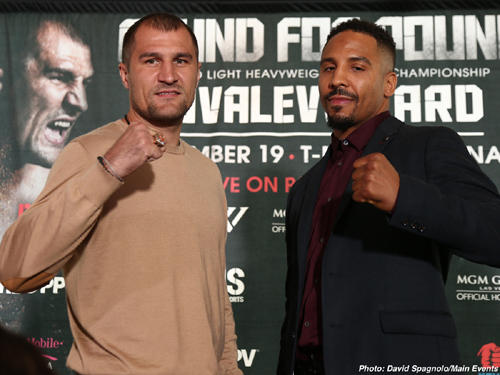
I’ve already stated that the body jab is the champion’s most effective weapon, but it’s his right hand which can end a fight at any given moment, and the challenger must somehow take it away from him. There are in fact numerous ways Ward can do this. For starters, he could crowd it. Power needs room to generate, and if there is no space, then there is no power. Conversely, Ward could move in a counterclockwise direction to stay in a “blindside” position from Kovalev’s right hand before raiding from an unexpected angle with either a left hook, or a right to the body-left hook to the head combination.
Logic tells us that punchers like Kovalev – whose power is contingent on distance, leverage and timing – must be kept off balance and prevented from getting set by use of feints and lateral movement. We saw similar tactics employed recently by Terence Crawford, who successfully nullified Viktor Postol’s jab, along with the subsequent right hand, by turning southpaw and moving both left and right. But unlike Postol, Kovalev is a more polished fighter who can land his right hand “cold,” without setting it up off the jab. On top of that, Crawford is better fighting as a southpaw, whereas Ward is more effective with his stronger left hand up front so he can jab and hook with it. Turning southpaw would no doubt make it more difficult for Kovalev to land his jab to head and body, but doing so could inadvertently clear a path for Kovalev’s right hand.
Whatever Ward does, he will have to mix things up and be prepared to improvise if necessary. Kovalev is far from one-dimensional, so it’s unlikely any single tactic will be enough to neutralize him from start to finish.
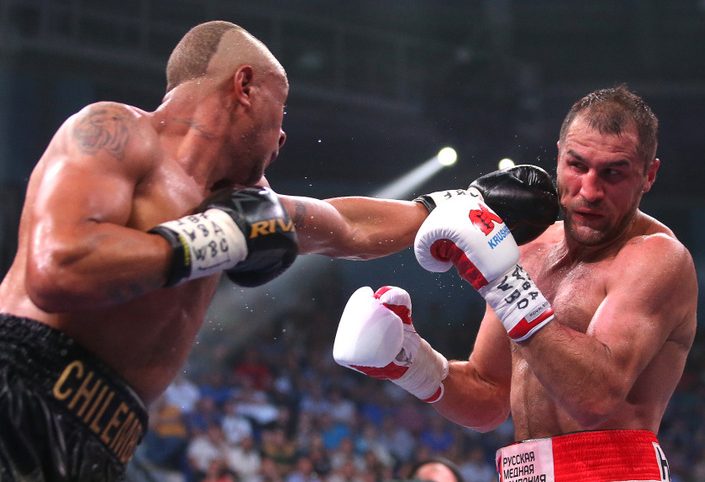
Conclusion: When the fight was first announced, my immediate thought was Ward’s boxing would simply be too nuanced for the powerful Russian to contend with and Kovalev’s performance against the awkward Isaac Chilemba reinforced my line of thought. Sergey notched up another win, but in far less convincing fashion than in previous fights. Chilemba moved intelligently, feinted, gave Kovalev different looks, and took his head off-center while jabbing up and down. He gave Kovalev more than his fair share of problems using many of the same tactics Ward frequently employs. And Chilemba doesn’t employ them anywhere near as effectively as Ward.
Clear as day, then, I envisioned the more calculating boxer systematically deconstructing the bigger puncher for an easy, unanimous decision win.
That was, until I re-watched Kovalev’s victory over Bernard Hopkins.
In that fight, a clearly more dialed-in Kovalev feinted often, jabbed to the body incessantly, and governed the center of the ring. Hopkins couldn’t control the distance and wound up lunging forward and throwing himself off balance throughout. Kovalev also showed he has the discipline to stick to a specific gameplan from start to finish. It was a masterclass in ring generalship. But what really stood out for me was that Kovalev managed to outbox a master boxer (albeit a 49-year-old one) with pretty much the threat of his right hand alone. After the knockdown in round one, Hopkins was so preoccupied with Kovalev’s right that he overreacted to anything that even remotely resembled one, and soon lost sight of what he needed to do to win. In other words, he lost control of the contest the moment he felt Kovalev’s power.
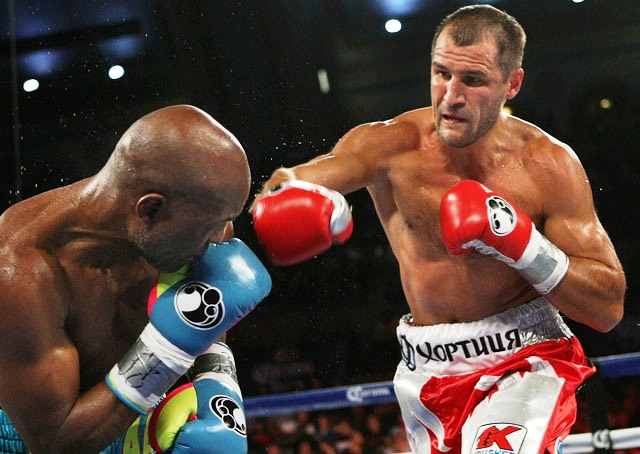
Ward has the boxing sophistication to make Kovalev look ordinary, but punching power is the one variable that no fighter, regardless of his ring IQ, can ever truly prepare for. It’s the ultimate game-changer. And Kovalev’s punching power is extraordinary. This is why, after much deliberation, I now find myself leaning towards Kovalev.
Ward is a very good defensive boxer, but I don’t consider him to be an upper-echelon defender like Floyd Mayweather Jr. or Pernell Whitaker. As good as Ward is defensively, he’s not untouchable. He will get hit. And when he does, I sense his demeanor may change for the worse.
When you think about it, Ward has less margin for error than Kovalev. He cannot afford to be less than flawless, whereas Kovalev could conceivably get outboxed, score a knockdown or two (when was the last time Kovalev failed to hurt or drop an opponent?) and still win by knockout or decision. A stoppage win for Ward is not impossible, though unlikely considering Ward has never been much of a puncher and is probably even less of one at the higher weight. The challenger is clearly more versatile, but I don’t believe he has as many avenues for victory as Kovalev does.
From the outside, Kovalev’s rangy style could potentially frustrate Ward into making mistakes. “Krusher” isn’t as cerebral as Ward, but he’s very good at using his feet to manage distance and set traps. And it’s not a given Ward will be able to get the better of Sergey on the inside either. As excellent as he is at close-quarters, much of Ward’s effectiveness there is predicated on him being the physically stronger man; I highly doubt he will be stronger than Kovalev.
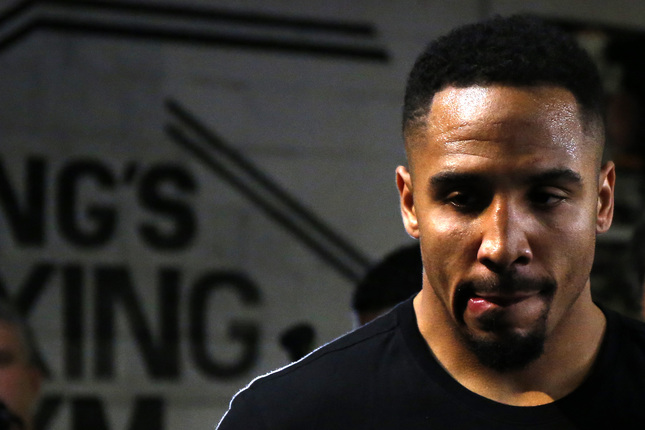
Besides, Ward’s in-fighting skills will only come into effect if the champion tries to actively compete with him inside. Going off past fights, Kovalev often puts an end to any in-fighting by placing his opponent in a headlock or by leaning on him, similar to Muhammad Ali who wasn’t great inside either and knew how to render an aggressive opponent ineffective by clamping down on the back of the neck. It’s also worth noting that Ward is not always the most subtle when it comes to getting inside. Sometimes he’ll tip his hat and bum-rush his opponent instead of closing naturally behind punches or off of slips. He’ll pay the price if he does that against Kovalev.
Although there have been exceptions, historically speaking this kind of match-up usually favors the better defensive fighter: Johnson vs Jeffries; Tunney vs Dempsey; Ali vs Foreman; Hopkins vs Trinidad; Mayweather vs Pacquiao, the list goes on. But in many of these contests, physicality also played a part as the more skilled defender was also able to physically restrain the bigger puncher. Again, I very much doubt Ward will be able to manhandle Kovalev like he did many of his opponents at 168 pounds.

Mentally, Ward is still razor sharp. But considering age, inactivity and now the step up in weight, I don’t think he is physically the same fighter he was back at the time of the Super Six tournament. And I suspect a less mobile and more hittable Andre Ward will experience many of the same problems Bernard Hopkins did against Kovalev.
Ward will do better than Hopkins, but I don’t think he will have an answer for the champion’s long jab to the body, or the feints and threat of the right hand which will keep him honest and from seizing the initiative. Consequently, I think Ward may struggle to find the right range, the eye of the storm so to speak, where his faster hands and shorter punches will have more impact, and where Kovalev’s straighter, more powerful blows will be nullified. The fight will probably go the distance, but I don’t think Ward will be busy enough from the outside, or effective enough on the inside, to win more rounds than “Krusher” and swing the judges’ verdict his way. — Lee Wylie




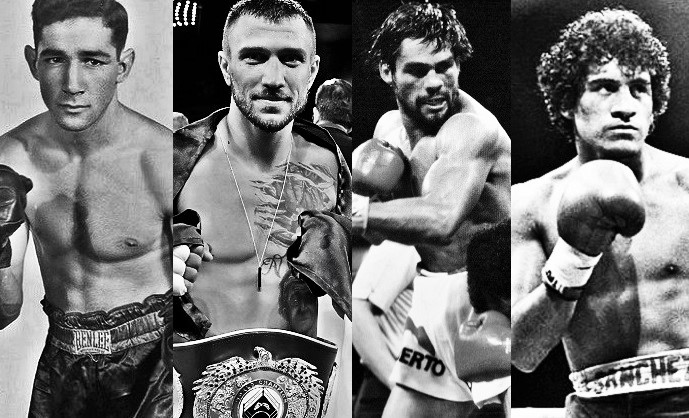

Masterful analysis! Thanks.
Thank you for this breakdown! After the RingTV survey went 26-11 for Ward I thought I was taking crazy pills, but you point out why this is must-see boxing.